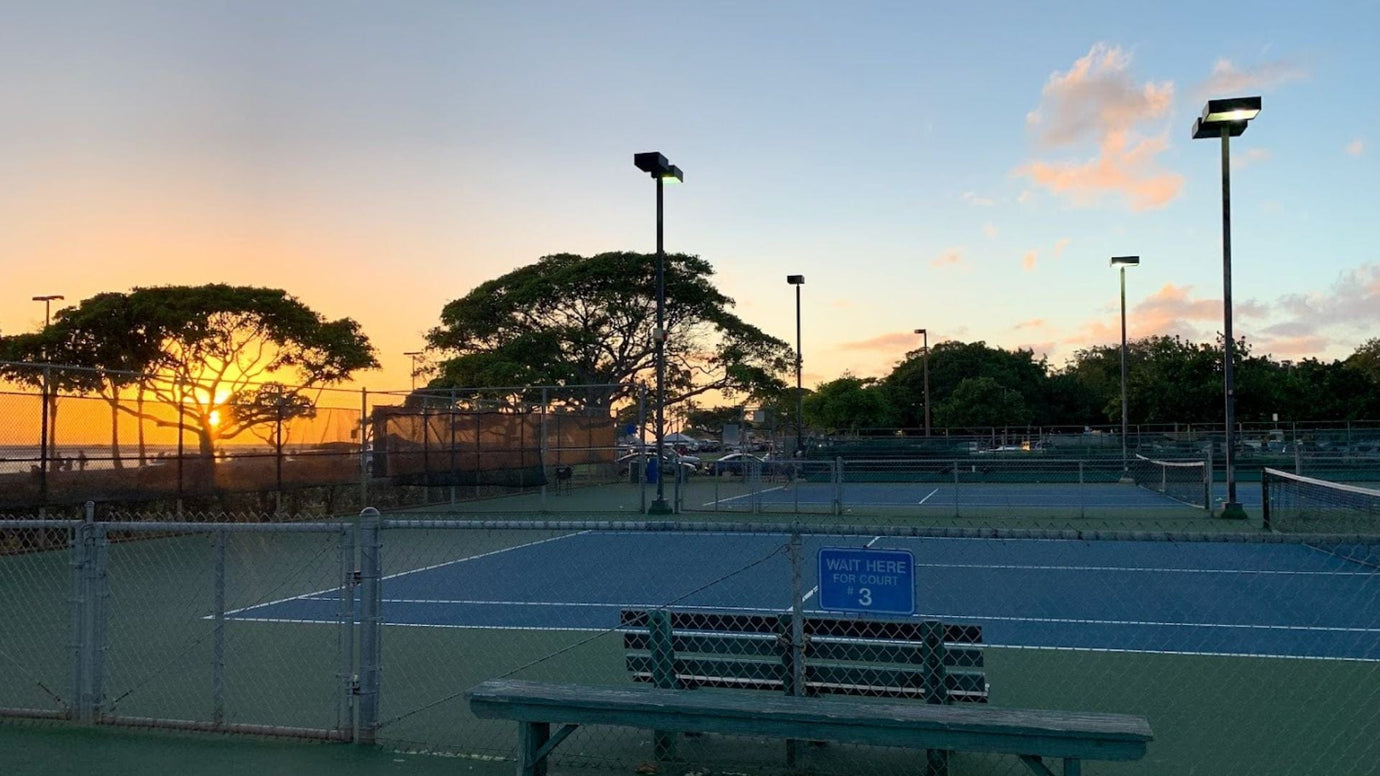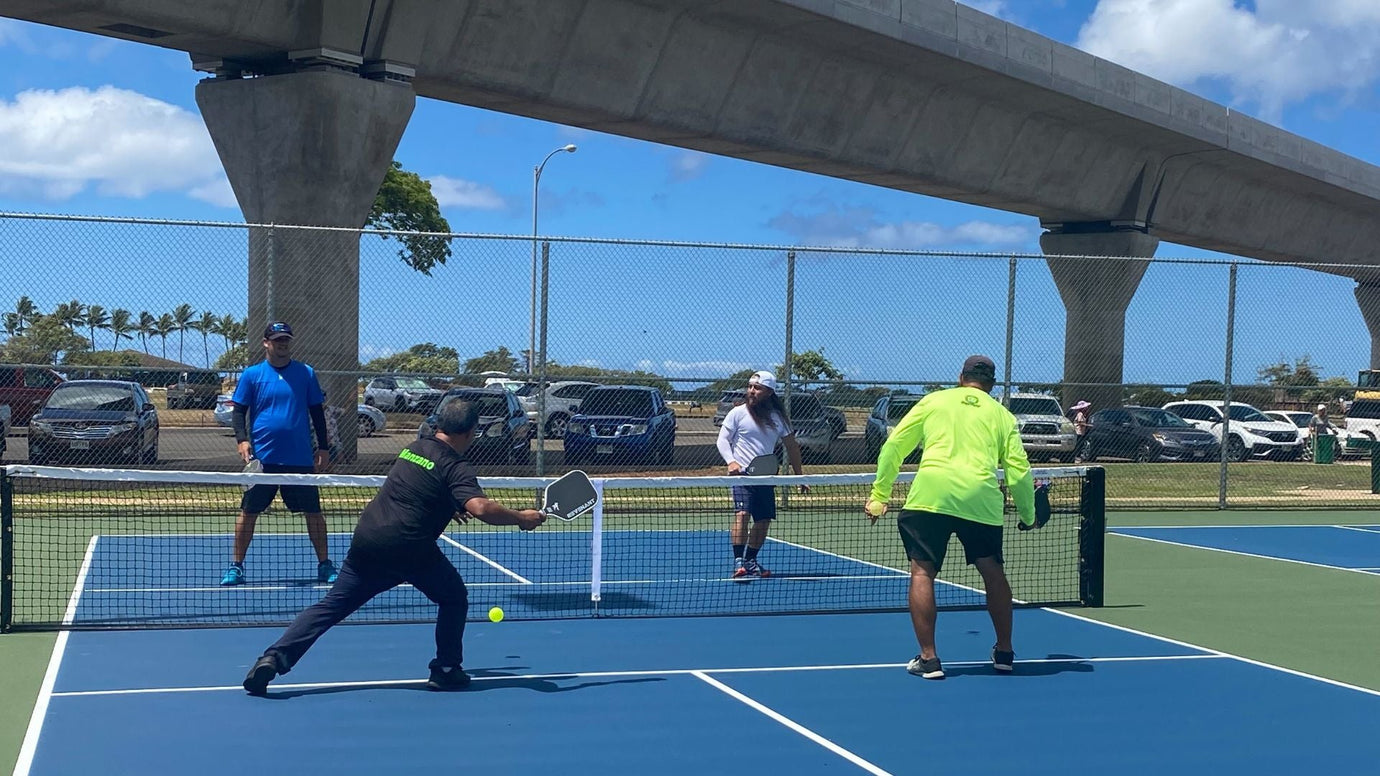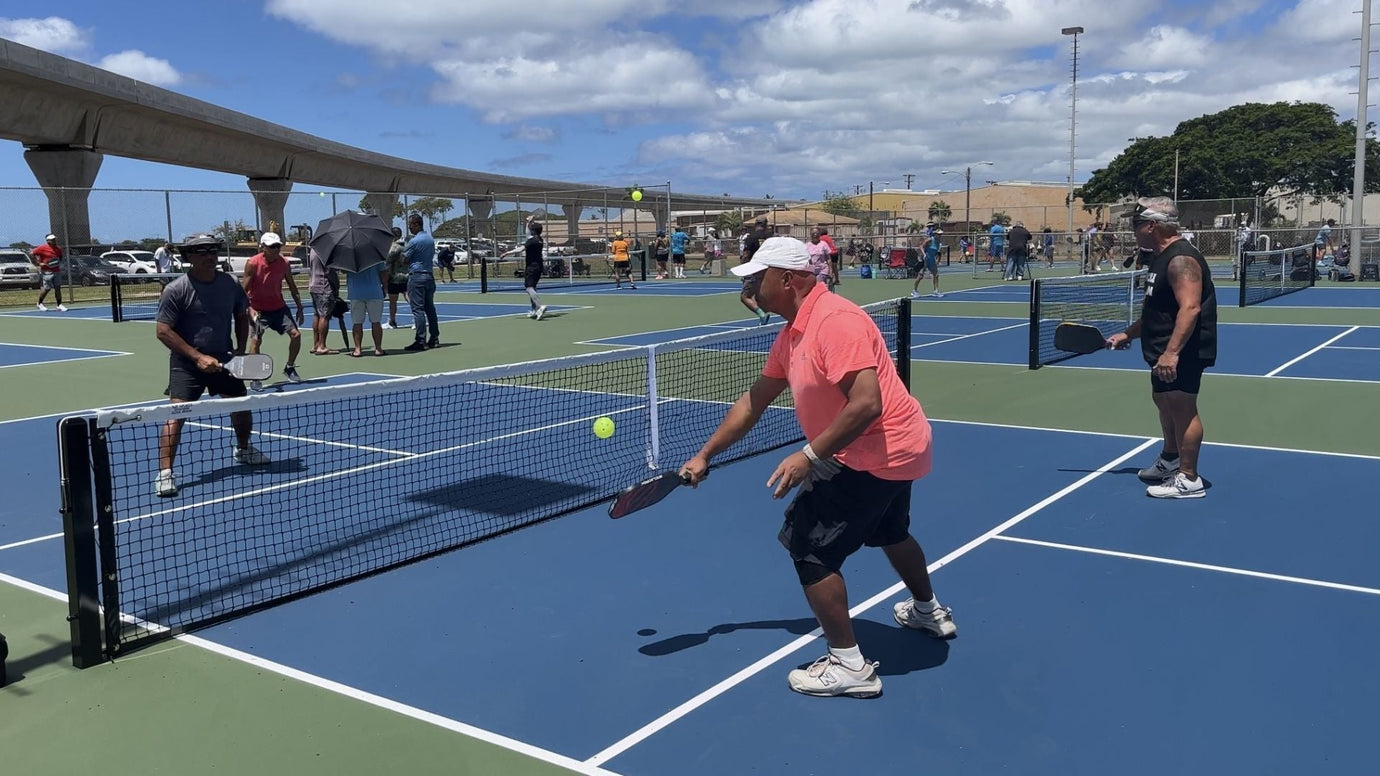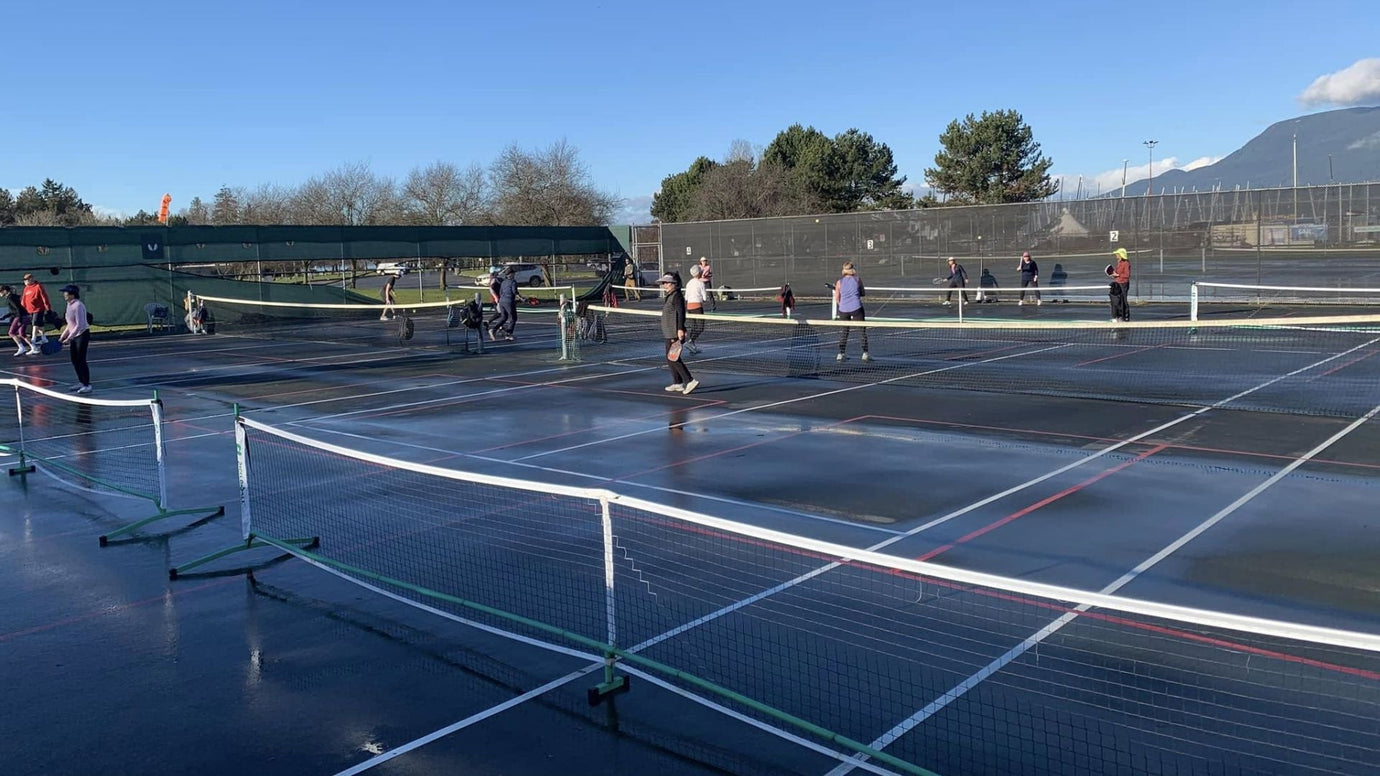Ready to dive into pickleball? You're not alone! Pickleball has rapidly become the fastest-growing sport in America, and it's incredibly fun. This comprehensive guide is perfect for everyone, whether you're a complete beginner or an experienced player looking to refine your game. By following these straightforward rules and tips, you'll be playing pickleball like a pro in no time.
Pickleball Fundamentals
To get started, all you truly need is a quality pickleball paddle and some pickleballs. The best way to begin is by taking a private lesson or joining a beginner's clinic. Often, these programs will provide the necessary gear if you're not ready to invest in your own equipment just yet.
Pickleball is played on a court the size of a badminton court (20 feet by 44 feet), featuring a net at each end. The net measures 36 inches high at the sidelines and 34 inches at the center. A crucial area is the non-volley zone, commonly known as the 'kitchen,' which is a 7-foot area on each side of the net where players are prohibited from hitting volleys.
While the sport can be played as singles, it is most frequently enjoyed as 'doubles,' with two players per team. If you're interested in exploring singles or doubles strategies further, additional guides are available.
Below, we'll delve into the seven core rules of pickleball, providing both a quick overview and detailed explanations for each.
Seven Core Rules of Pickleball
Rule 1: The Serve
Every rally in pickleball begins with a serve. The player on the right side of the court always initiates the serve. The serve must be delivered diagonally to the opponent. The server can either hit the ball out of the air (a volley serve) or after it bounces (a drop serve), and the ball must clear the entire non-volley zone (kitchen), including the line.
For a volley serve, the ball must be struck with an underhand motion, where the paddle contact with the ball is below the waist. The paddle must move in an upward arc during the serve.
Rule 2: The Two-Bounce Rule
Before any player can hit a volley (a shot hit out of the air), the ball must have bounced once on each side of the court. This is often referred to as the ‘two-bounce rule.’ This rule prevents the serving team from rushing the net and gaining an unfair advantage immediately after the serve.
Rule 3: Play Continues Until a Fault Occurs
After a legal serve, play continues until one team commits a fault. A fault ends the rally. Common faults in pickleball include:
- The serve landing outside the service area or in the non-volley zone.
- The ball going out of bounds.
- The ball hitting the net and failing to clear it.
- Failing to observe the two-bounce rule.
Rule 4: No Volleying in the Kitchen (Non-Volley Zone)
The non-volley zone, or ‘kitchen,’ is a 7-foot area on both sides of the net. Players are strictly prohibited from hitting a volley while any part of their body is in this zone. Additionally, after hitting a volley, a player’s momentum cannot carry them into the kitchen.
Rule 5: Only the Serving Team Can Score Points
Traditionally, points in pickleball can only be scored by the serving team. When the serving team wins a rally, they score a point, and the server and their partner switch sides of the court. The same player continues to serve until their team loses a rally. If the serving team loses a rally, the serve then ‘sides out,’ meaning the serving opportunity switches to the opposing team.
Rule 6: Understanding the Score
Pickleball scores are typically called out using three numbers, for example, “0-0-2.” Each number represents:
- First Number: The serving team’s score.
- Second Number: The receiving team’s score.
- Third Number: Which player on the serving team is serving (1 for the first server, 2 for the second server).
For instance, if the score is 3-3 and you are the first server, you would announce “3-3-1.” If your team loses a rally, your partner would then serve, announcing “3-3-2.” If your partner also loses the rally, it’s a ‘side-out,’ and the serve goes to the opposing team. The exception to this scoring announcement is at the very beginning of the game, where the first server announces “0-0-2.” This is because the team starting the game only gets one serve before a side-out, as they have the advantage of serving first.
Rule 7: Win by Two Points to 11
Following all the rules, the game continues until one team reaches 11 points. However, to win, a team must have a lead of at least two points. If the score is tied at 10-10, play continues beyond 11 points until one team achieves a two-point lead (e.g., 12-10, 15-13, or even 21-19). These extended games are often the most exciting and enjoyable.
Pickleball Gear
Beyond paddles and pickleballs, you might also need a net if the courts in your area aren't already equipped. Investing in pickleball-specific clothing, such as socks and shoes, can also enhance your game.
For local pickleball courts, if the court is already marked, you can simply show up and start playing. If there are permanent lines but no net, you'll need a mobile net. This can be placed in the middle of the court, similar to a tennis net.
Pickleball Shots
Let's explore some of the different shots you can play in pickleball:
- Drives: These are powerful shots often hit from the baseline, typically with a backhand or forehand swing.
- Drop Shots: Played from the back of the court, these shots aim to land softly into your opponent's kitchen to prevent them from attacking.
- Dinks: Similar to a drop shot but played closer to the net, these touch shots are used to hit the ball into your opponent's kitchen, making it difficult for them to generate power.
- Volleys: A shot made before the ball bounces, hit out of the air. These shots can only be used outside the kitchen. They are often hit high in the air to keep opponents from entering the kitchen.
- Overheads: These shots are hit with a tennis-serving motion above the head, primarily used to counter lobs.
Pickleball Serve Details
The serve is the initial action of every pickleball rally. Unlike tennis, the pickleball serve is not primarily intended to be an offensive weapon but rather to put the ball into play. According to USA Pickleball Official Rules, a volley serve (where the ball is hit out of the air) must be executed with an underhand stroke, ensuring contact with the ball occurs below the waist. The arm must move in an upward arc, and the highest point of the paddle head must be below the wrist at the moment of contact. The pickleball serve is characterized by an underhand backhand or forehand stroke with an upward motion.
While traditional pickleball serves are hit out of the air, USA Pickleball introduced the ‘drop-serve’ in 2021, allowing players to drop the ball and hit it after it bounces.
Where to Serve in Doubles Pickleball
In doubles pickleball, you serve diagonally across the court. For a serve to be valid, it must land within the opponent’s service area, which is defined by the baseline and sideline, and must completely clear the non-volley zone (kitchen line). The serve can land ‘on the line’ between the baseline and sideline, but not on the kitchen line.
Serving Stance
When serving, you must stand behind the baseline. Your feet cannot touch the baseline or sideline during the serve. The serving team should remain behind the baseline until the third shot has been hit. Running to the kitchen immediately after serving would result in a fault. The receiving team should adopt a ‘one-up-one-back’ position, as the serve will bounce first on their side, allowing them to immediately volley once the serve is returned.
Optimizing Your Pickleball Serve
While the primary goal of the serve is to initiate play, there are ways to improve its effectiveness:
- Serve Deep: Short serves force your opponent to run towards the kitchen line. A deep serve, conversely, keeps your opponent further back.
- Target Weaknesses: Aim your serve towards your opponent’s weaker side (forehand or backhand). This can lead to more errors or weaker returns.
- Add Spin (Advanced): By altering the angle of your paddle during your serve and follow-through, you can introduce spin. Spin can confuse your opponent and lead to unforced errors on the return.
Illegal Pickleball Serve
An illegal pickleball serve is one that violates the established serving rules. Key points to remember:
- A serve must land in the opposite (diagonally positioned) service area.
- The volley serve must be struck underhand and in an upward motion.
- The server of a volley serve must hit the ball below their waist.
- When serving, the server’s feet must remain behind the baseline.
- You must serve in the correct rotation and order.
Common Serving Mistakes (Faults)
Here are some other serving mistakes that can lead to a fault in pickleball:
- Foot Faults: The server steps over or on the sideline or baseline during the serve.
- Pre-Spun Serve: The ball is spun by the server before it makes contact with the paddle.
- Net Serve: If the ball hits the net but still lands within the correct service area, the serve is still valid and play continues.
- Missing the Serve: The server hits the ball into the wrong section of the opponent’s court, into the kitchen (including the kitchen line), or outside the baseline or sideline.
How to Keep Score and Start a Pickleball Match
The game begins with the serve. The USA Pickleball Rulebook states that “any method fair to all parties shall be used” to determine who or which team gets to serve first. This could be a coin toss, or some local courts might have a rule that the north side always serves first. It’s best to ask a local or devise your own method.
Once the serving side has been chosen, the player on the right side of the court is the first to serve. The announcer will always state the score at the beginning, which is “0-0-2.” The starting score for each team is 0, and the “2” indicates the position at which the team will serve (refer to Rule #6 for more on scoring).
When a fault is made or a rally is lost, a “side out” will occur, and the serve will go to the opponent. After the first side-out, each team typically has two chances to serve (first server, then second server), or until the losing team loses two rallies or serves. A “side out,” or “team-out,” occurs when the serving team has used up its two serves. The opposing team will then have their turn to serve.
It’s a lot of information to absorb, so let’s review how to begin a pickleball match:
- Choose the starting team: Use local rules or a coin toss.
- First server: The right-side player serves first.
- Announce the score: The first server announces “0-0-2” to start.
- Serve: Players serve (out of air or off-the-bounce) to the diagonal.
- Continue play: If the service is “good,” the play continues.
- Switch sides: If the serving team wins the first point, the next serve will be hit by the left side of the court. Points will alternate between left and right until the serve is “sided out.”
The Pickleball Two-Bounce Rule Explained
The “two-bounce rule” dictates that after a player serves, the ball must bounce once on each side of the court before any player is allowed to volley it out of the air. Let’s consider a doubles example:
- The first bounce occurs when a player serves the ball, and it lands on the opponent’s court.
- The serving team must then wait until the ball bounces again after the opponent has returned the ball.
Only after these two bounces have occurred can the ball be legally “volleyed.” A player positioned close to the net who has not yet fulfilled this rule cannot legally hit the ball in the air. It would be illogical for the serving team to start in the kitchen. Conversely, if you are on the receiving side but are not receiving the serve, it is logical to start in the kitchen, as the ball will always bounce twice before it reaches you. Once the two-bounce rule is met, all players are free to move into the kitchen and begin volleying. The kitchen area is often the most strategic position in pickleball.
Pickleball Doubles
Pickleball Doubles is the most popular variation, involving two players per team. This section provides a quick guide to optimal standing positions. Since doubles is the predominant variation, all rules discussed so far apply unless otherwise stated, including serving, scoring, and volleying.
Pickleball Singles
Pickleball Singles offers a great alternative to doubles. This version is identical to doubles, except there is only one player per side. The primary difference lies in which side a player serves from after a side-out (based on their score). Scoring also differs; the server only calls out two numbers, not including the opponent’s score.
Pickleball singles has five basic scoring rules:
- Each side begins the first serve on the right.
- If the server wins a rally, they move to the other side of the court.
- If the receiver wins, neither player switches sides.
- The server continues to serve (by switching sides from left to right) until they lose the rally. Each rotation has only one serve.
- If the server loses the rally, it’s a side-out, and the opponent gets the serve. In this version, there is no second server.
Determining Serve Side in Singles Pickleball
To determine which side of the court to serve from in singles pickleball:
- When the server has an even number of points (0, 2, 4, etc.), the serve will always be made from the right side.
- When the server has an odd number of points (1, 3, 5, etc.), the serve will be made from the left side.
All other pickleball rules, including serving, faults, line calls, and the non-volley area, remain the same as in doubles.
Solo Pickleball Drills
If you can’t find a partner, why not try some solo drills? They can significantly improve your skills and fitness, preparing you for your next match. There are a variety of pickleball drills to choose from. Beginner players can benefit from “paddle-up” and “selfie-ball bounce” drills, which enhance reflexes and coordination.
Practice Wall
You can maximize your practice time by utilizing a practice wall. Any flat vertical surface, such as a wall or garage door, will work. Repeatedly bouncing the ball off a wall is an excellent way to improve your shot accuracy, reflexes, and precision. Some players use a portable line or net to ensure their shots are taken at the right height. You can mark targets on your surface or purchase a “dinkpad” to hang on the wall.
Rebound Nets
Rebound nets are perfect for practicing alone, as they bounce the balls back at you, simulating an opponent. These nets can be placed in a driveway, yard, or basement. They can also be tilted to produce different return shots and are generally quieter, which keeps neighbors happy.
Pickleball Machines
If you are serious about improving your skills, a pickleball machine is a worthwhile investment. These machines offer various combinations of speed, angle, and spin, allowing you to practice in real-game situations. The Erne, for example, is projected to be a popular pickleball machine by 2024, capable of holding over 150 balls and controlled by a smartphone app for complex drills.
Pickleball Tips for Beginners
My favorite pickleball beginner tip for winning games is to move up to the kitchen once you have hit your serve and take control of the court. Many beginners struggle to score points when they play from the baseline.
- Keep your paddle ready: Hold your paddle ready (above your chest) in front of your body. Holding your paddle below your waist slows you down, and pickleball requires quick reactions.
- Looser grip for touch shots: When shooting touch shots, use a looser grip, around a 3/10 tightness. The tighter you grip, the greater your chances of popping up dinks or drop shots.
- Arm motion for dinks: Touch shots, especially dinks, should not be hit with the wrist. Instead, move your arm in a single motion from your shoulder. Dinks are a precision shot, and using your wrist can make them unpredictable.
- Get low and bend your knees: If you are hitting a drive shot or a touch-shot, getting low and bending your knees will increase your accuracy and power.
- Avoid the lob: Although it feels great to catch your opponent by surprise with a lob, this shot is low-percentage, especially given the small size of pickleball courts. Instead, focus on dinks and higher-percentage shots.
- Be patient: Saving your best shots for the right moment and not rushing points is crucial for success in pickleball. Wait for the perfect opportunity to attack rather than forcing difficult shots.
Conclusion
Pickleball is a dynamic and engaging sport that offers a fantastic blend of exercise, strategy, and social interaction. Whether you're just starting out or looking to refine your skills, understanding the fundamental rules, mastering various shots, and practicing regularly are key to enjoying and excelling in the game. With its simple learning curve and accessible nature, pickleball continues to captivate players of all ages and skill levels. So grab your paddle, head to the court, and enjoy the fastest-growing sport in America!
Frequently Asked Questions (FAQs)
Q1: What is pickleball?
A1: Pickleball is a paddle sport that combines elements of badminton, tennis, and table tennis. It is played on a court with a net, using a paddle and a plastic ball with holes.
Q2: Why is it called pickleball?
A2: The name 'pickleball' originated from the family dog, Pickles, who would chase after the balls during early games. It was later suggested that the name might also be related to the term 'pickle boat' in crew, where oarsmen are chosen from the leftovers of other boats.
Q3: Is pickleball an Olympic sport?
A3: As of August 2025, pickleball is not an Olympic sport. However, its growing popularity has led to discussions and efforts to include it in future Olympic Games.
Q4: How big is a pickleball court?
A4: A standard pickleball court is 20 feet wide and 44 feet long, the same size as a badminton doubles court.
Q5: Can you play pickleball on a tennis court?
A5: Yes, you can play pickleball on a tennis court. The dimensions of a pickleball court can be taped or painted onto a tennis court, and a portable pickleball net can be set up.
Q6: What is the 'kitchen' in pickleball?
A6: The 'kitchen' is the non-volley zone, a 7-foot area on each side of the net where players are not allowed to hit the ball out of the air (volley). Players can enter the kitchen to retrieve a ball that has bounced, but they must exit before volleying.
Q7: How do you score in pickleball?
A7: In pickleball, points are only scored by the serving team. Games are typically played to 11 points, and you must win by at least two points.
Q8: What is the two-bounce rule?
A8: The two-bounce rule states that after the serve, the ball must bounce once on the receiver's side and once on the server's side before either team can hit the ball out of the air (volley).
Q9: What are the common faults in pickleball?
A9: Common faults include hitting the ball out of bounds, hitting the net and failing to clear it, volleying in the kitchen, and failing to observe the two-bounce rule.
Q10: What equipment do I need to play pickleball?
A10: To play pickleball, you primarily need a pickleball paddle and pickleballs. A net is also necessary, and comfortable athletic clothing and shoes are recommended.







